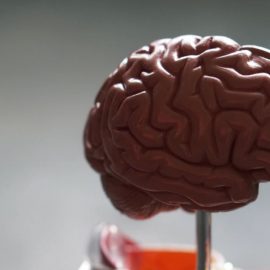
Does going for a run feel like you’re fighting against your deepest instincts? What if the natural resistance to exercise isn’t a character flaw but an evolutionary feature?
Daniel Lieberman’s Exercised: Why Something We Never Evolved to Do Is Healthy and Rewarding tackles these puzzles. The Harvard evolutionary biologist reveals how our ancestors conserved energy for survival while explaining why modern humans must actively pursue fitness to stay healthy.
Keep reading to discover how understanding humans’ evolutionary past can transform your approach to staying active and well.
Overview of Daniel Lieberman’s Exercised
We know we need to exercise to stay healthy, but lacing up and going for a jog can feel like fighting our most basic instincts. Why? According to Daniel Lieberman’s Exercised: Why Something We Never Evolved to Do Is Healthy and Rewarding, it’s because humans evolved to conserve energy. Our ancestors did a lot of daily physical activity for survival, not for fitness. When our ancestors weren’t busy finding food, caring for children, or avoiding danger, they rested. Rest ensured they had enough energy for what mattered most: reproducing.
(Shortform note: Another way to understand Lieberman’s concept of energy conservation is by comparing it to the economic principle of supply and demand. In economics, resources are allocated based on demand, and efficiency is achieved by minimizing waste. Similarly, our bodies allocate energy based on perceived needs, conserving it when the demand for energy is low. However, unlike economic systems that can adapt rapidly to changing conditions, our bodies have a slower response to the drastic shifts in lifestyle brought about by modern technology. This lag results in a mismatch between our evolved physiology and our current environment, leading to health problems associated with inactivity.)
Our modern lifestyle releases us from the need to do physical activity to survive. Today, most of us no longer hunt, grow food, or walk several miles to find water and shelter. But Lieberman argues that our bodies still expect physical activity. So, it’s important for us to exercise—to engage in voluntary physical activities. When we don’t, we become sick.
(Shortform note: Why are we less active than people were in the past? Some experts point to the development of technology, rather than any other cultural or economic shifts. When machines take over jobs that previously required physical labor, we end up with fewer reasons to get moving. Research shows that 100 years ago, people got an average of five times more daily exercise than we do today.)
In his book Exercised, Daniel Lieberman examines exercise through the lenses of evolutionary biology and anthropology to help readers understand that our natural reluctance to exercise isn’t a moral failing. It’s an ingrained evolutionary trait. He also explains why we still need to exercise, what kind of exercise we need, and how much. Additionally, he suggests ways to motivate yourself to lace up and go for that jog.
Lieberman is an evolutionary biologist and a professor of biology at Harvard University. His research focuses on how and why the human body evolved to move the way it does, particularly in relation to physical activity and exercise. His studies on barefoot running and early humans’ endurance running earned him the nickname “the barefoot professor.” His research also earned him a place at the center of a running controversy: Is running barefoot better for us than running with specially designed shoes? The controversy showed Lieberman that people are exercised—as in stressed out—about exercise, how to do it properly, and what kind of exercise to do. This is what inspired him to write Exercised.
The first part of this overview of Daniel Lieberman’s Exercised: Why Something We Never Evolved to Do Is Healthy and Rewarding explores his claim that our ancestors didn’t exercise. Then, we’ll address why modern humans do need to work out. The overview concludes with Lieberman’s advice for your health and fitness from an evolutionary and anthropological perspective.
Our Ancestors Didn’t Exercise
Lieberman’s studies of pre-industrial communities and our primate ancestors led him to the realization that humans never evolved to exercise. The voluntary physical activity we do to achieve health and fitness goals is a modern concept, as our ancestors engaged in physical activity out of necessity rather than for health benefits. This section explores why humans evolved to conserve energy and how our bodies evolved to do this.
Why Humans Evolved to Conserve Energy
Lieberman argues that we evolved to conserve energy and avoid unnecessary exertion—not out of laziness, but as a survival advantage. Organisms have a limited number of calories to spend on competing needs: growing, maintaining and healing the body, storing energy for times of scarcity, powering necessary activity, and reproducing.
From an evolutionary perspective, it makes sense to avoid unnecessary physical activity, as those calories could instead be used for reproduction or survival. Lieberman explains that the human body expends significant energy even at rest, with basic bodily functions spending around 1,700 calories per day for an average adult male.
Being physically inactive might be our evolutionary default state. Modern-day hunter-gatherers expend about twice as many calories per pound of body weight compared to primates because humans have larger brains and have babies more often. According to Lieberman, this makes humans even more prone to avoid unnecessary physical activity than our primate relatives, as we have higher energy requirements.
| Energy: The Driving Force of Evolution Our need to conserve energy has been shaping evolution for millions of years—even before our primate relatives came into the picture. In Seven and a Half Lessons About the Brain, neuroscientist Lisa Feldman Barrett explains that the brain’s most important job is allostasis, managing the body’s energy budget to increase the odds of survival and reproduction. Allostasis sets the course for our brain’s evolution. Barrett explains that, before brains existed, primitive organisms had energy-budgeting cells that kept track of their energy needs. These cells signaled to the rest of the organism’s body when it needed to eat, move to find food, or rest—whichever would preserve its energy best in that moment. During the Cambrian period (starting about 541 million years ago and lasting for about 56 million years), primitive animals began evolving into more complex organisms with new organs and internal systems. The more complex an organism is, the more complex its energy budgeting is because each organ and system has specific energy requirements. To cope with this new complexity, the primitive energy-budgeting cells clustered together to form a brain. In Your Inner Fish, paleontologist Neil Shubin explains why complex organisms have higher energy requirements, further clarifying why a human might need as many as 1,700 calories a day. Early Precambrian creatures were made of the same type of “glue” (collagen and proteoglycan) that allows cells to stick together to build organs. However, more evolved organisms require this glue to be a different mix of molecules depending on the organ it’s forming—for instance, a bone versus an eye. It requires more energy to create the right “glue” and assign it to the right body part or system. |
As we’ll see later in this overview, our evolutionary tendency to conserve energy has become problematic in our modern industrialized world, where physical labor is minimal and many of us live sedentary lifestyles.
How Humans Evolved to Conserve Energy
Through his studies of pre-industrial communities, Lieberman realized that exercise is, from an evolutionary standpoint, a new idea. Our ancestors didn’t go out for jogs or lift heavy rocks to tone their arms. However, they were physically active every day, doing several hours of light activities, such as preparing food. They spent a few hours each day on moderate activities such as walking for long distances to get food or water, and the occasional intense activity, like running from predators. As a result, our bodies evolved to be as energy-efficient as possible while allowing us to get enough food to survive and reproduce.
(Shortform note: Other scientists refer to the ancestral lifestyle Lieberman describes as a Paleolithic rhythm. Anthropologists who observed contemporary hunters and gatherers found that their way of life still largely follows this rhythm, which mirrors medical recommendations for physical activity. This natural cycle of intermittent activity was likely the norm for most of human existence. However, experts still debate the specific pattern of the rhythm. While Lieberman believes our ancestors spent a few hours each day doing moderate physical activities, other anthropologists argue that early humans spent one or two days doing intense physical activity such as hunting and gathering food, followed by one or two days of rest.)
This section will explore three ways the human body evolved to thrive while maintaining energy efficiency.
Adaptation 1: Walking Efficiently on Two Legs
Lieberman explains that human bipedalism—walking on two legs—evolved as an energy-efficient solution when climate change forced our primate ancestors to travel farther for food. The bodies of our primate relatives, such as chimpanzees, are adapted for climbing trees, not moving on two legs. At some point, the climate where they lived changed, forcing them to walk to find suitable food. Evolution favored certain adaptations that made walking efficient. These include a curved spine, bowl-shaped pelvis, and other anatomical features that help us maintain balance and conserve energy while walking on two legs.
(Shortform note: Lieberman’s explanation of the evolution of bipedalism may be an oversimplification. Besides being an energy-efficient response to climate change, bipedalism may have offered early humans several advantages. For example, it likely freed the hands for carrying tools and improved the ability to detect predators in tall grasses. It’s possible that a combination of these advantages, rather than a single one, contributed to the evolution of bipedalism.)
Adaptation 2: Lean Strength
Throughout most of human evolution, excessive muscle mass was more of a liability than an asset because of its high caloric cost. Studies of groups like the Hadza in Tanzania and the Aché in Paraguay show that modern-day hunter-gatherers are generally lean and moderately strong, but not particularly muscular. Our ancestors were likely similar—fit and capable, but not up to modern bodybuilding standards.
Lieberman argues that the modern obsession with building extreme muscle mass is neither natural nor necessary. He argues that moderate strength—enough to perform daily activities—is sufficient for most people.
(Shortform note: You can take a cue from modern-day hunter-gatherers by trying functional fitness, which focuses on training muscles to perform daily tasks efficiently and safely. This approach to exercise emphasizes the importance of strength and physical capability to support everyday activities and overall health, rather than aesthetic goals. Functional fitness can prevent the negative outcomes associated with an excessive focus on muscle mass, such as disordered eating, body image issues, and potential health problems from overtraining or the use of performance-enhancing drugs. Additionally, functional fitness encourages a balanced approach to fitness that prioritizes overall well-being.)
Adaptation 3: Endurance Running
Lieberman believes humans adapted for endurance running. Numerous adaptations make humans uniquely suited for long-distance running, including our ability to cool through sweating, our springlike tendons, and the nuchal ligament that stabilizes our head while running.
Lieberman argues that these running adaptations developed to enable persistence hunting—the practice of chasing prey animals for hours until they collapse from exhaustion. Once the animal was exhausted, humans could kill it more easily. This hunting method, documented in various cultures worldwide, takes advantage of humans’ unique ability to run for hours while maintaining relatively cool body temperatures.
| The Possible Impacts of Hunting on Evolution Other experts disagree with Lieberman’s hypothesis, suggesting he overstates the importance of persistence hunting for early humans. They argue this mode of hunting was rare and couldn’t have exerted enough pressure to influence human evolution (such as the adaptations Lieberman mentions). For example, most known cases of persistence hunting are in arid environments, unlike the wetter savanna-woodlands where the first humans evolved. Additionally, they point out that effective persistence hunting demands advanced tracking skills, which were potentially beyond the capabilities of early humans. While experts are still debating the impact of persistence hunting, they agree that the general practice of hunting had some impact on human evolution. Around 2.6 million years ago, as the populations of large animals dwindled, early humans needed more skill to catch smaller and more agile prey. Think, for instance, about the skills needed to hunt a large and conspicuous mammoth versus the skills needed to catch a quick-moving hare using primitive tools. Scientists believe this change demanded more of human brains and triggered a period of growth where brains got much larger—possibly to accommodate those new hunting skills. |
Modern Humans Need Exercise
Although our ancestors didn’t exercise, modern humans should. That’s because our ancestors had to work much harder than us for fewer calories as they foraged for, hunted, or grew their own food. The modern benefit of easy calories and easy living comes at a cost: exercise.
This section will explore why modern humans need to exercise even though our ancestors didn’t. It will also discuss how exercising prevents disease and senescence, the gradual deterioration of health that we typically associate with aging.
Our Modern Bodies Need Exercise
As we’ve seen, surviving and reproducing was our ancestors’ full-time job. Their lifestyles included daily, moderate physical activity and securing just enough calories to survive and reproduce. However, most modern humans lead lifestyles where daily moderate physical activity isn’t necessary for survival, and we have access to more calories than we need.
Although our lifestyles have changed dramatically, our bodies haven’t caught up. According to the Costly Repair Hypothesis, our bodies require physical activity to maintain health. When we exercise, our bodies release stress hormones, cells leak harmful chemicals that can damage DNA, and muscles develop microtears. The body’s response to this exercise-induced damage is comprehensive and beneficial. It includes lowering heart rate and stress hormones, mounting anti-inflammatory responses, and repairing DNA. These repair mechanisms often overcompensate for the damage, making the body healthier than before the stress of exercise.
The evolutionary logic behind the Costly Repair Hypothesis is that organisms with limited energy must carefully allocate resources to reproduction, movement, and body maintenance. Natural selection favored individuals who could efficiently match their repair capacity to the demands of physical activity—not invest too much or too little energy into repair. This system evolved to activate maintenance and repair mechanisms in response to physical activity, but not necessarily without it.
Unfortunately for exercise-averse modern humans, we can’t simply trigger these repair mechanisms without exercise. Our ancestors never experienced a lifestyle without regular physical activity, so we never evolved mechanisms to activate these repairs without the stress of exercise.
Exercise Prevents Disease
The absence of regular physical activity allows disease and faster aging because our bodies aren’t getting the signals they evolved to expect to activate crucial repair processes. Lieberman argues that many chronic diseases, including those commonly associated with aging, result from a lack of physical activity. He characterizes these diseases as the results of evolutionary mismatches: Our bodies are poorly adapted to aspects of modern life like smoking, obesity, and sedentary lifestyles.
Lieberman supports this hypothesis with statistics showing how rare these conditions are among the elderly in modern-day hunter-gatherer societies. Exercise helps prevent and treat many modern diseases by activating the maintenance and repair mechanisms that evolved to respond to physical activity.
Below, we’ll examine several conditions that Lieberman argues are the result of evolutionary mismatches. They’re virtually nonexistent in modern-day hunter-gatherers, but their numbers have increased exponentially in our modern societies. We’ll explain how exercise can help prevent or manage each condition.
Infectious Diseases
Lieberman argues that lack of exercise weakens our immune function and makes us more vulnerable to pathogens. By contrast, physical activity boosts our immune system by deploying immune cells to vulnerable areas like the respiratory tract and improving vaccine response. Moderate cardio exercise appears most beneficial, with studies showing that 45 minutes of walking five times a week can reduce respiratory tract infections.
Metabolic Disorders
Exercise is essential for preventing metabolic disorders such as obesity, type 2 diabetes, and cardiovascular disease. When we eat more calories than we expend, excess calories are stored as fat, leading to enlarged fat cells that disrupt our metabolism. Lieberman outlines how obesity, poor diet, stress, and inactivity can lead to insulin resistance, where cells fail to respond to insulin—the hormone that helps our body turn sugar into energy. This results in high blood sugar levels that, over time, can damage vital organs like the heart and kidneys.
Lieberman explains that physical activity is crucial for maintaining a healthy weight and preventing the negative effects of obesity. In addition, regular exercise prevents diabetes and lowers blood pressure by improving your metabolism, including reducing organ fat and regulating blood sugar levels.
Lieberman suggests spending at least 150 minutes a week on moderate-intensity exercise, emphasizing that a combination of cardiovascular and strength training is best. This approach not only helps prevent and manage diabetes but also lowers triglycerides and raises HDL (good cholesterol), significantly decreasing the risk of cardiovascular diseases.
Musculoskeletal Disorders
Lieberman explains that exercise can prevent three major musculoskeletal conditions: sarcopenia (muscle loss), osteoporosis (weak bones), and osteoarthritis (degraded joints). Our muscles consume a lot of energy, so our body eliminates muscle cells if it suspects we don’t need them. Similarly, our bodies naturally deplete bone cells as we age. The best way to keep healthy muscle mass and bone density is to exercise our bones and muscles often with resistance training. Finally, exercise can also protect your joints by preventing excess body weight, which can inflame and degrade the cartilage.
Oncological Disorders
Cancer involves cells that mutate and divide uncontrollably, competing for resources with healthy cells. Lieberman argues that physical activity helps prevent cancer through multiple mechanisms, such as regulating reproductive hormones that trigger mutations, reducing blood sugar availability to cancer cells, and enhancing immune function to suppress cancer cells. In addition, higher levels of exercise generally show a stronger impact.
Exercise Prevents Senescence
In addition to preventing illness, exercise significantly improves the probability of aging well—avoiding the health deterioration that often happens as we age. Lieberman cites evidence from modern-day hunter-gatherer societies to demonstrate that humans evolved to be physically active into old age, and avoiding a sedentary lifestyle helps us age well.
We Evolved to Be Active Into Old Age
According to Lieberman, the Active Grandparent Hypothesis helps explain why physical activity is so effective at fighting senescence.
Compared to our primate relatives, we live much longer, way past our reproductive prime. According to the Active Grandparent Hypothesis, evolution favored longevity in humans because grandparents who were still around and active could help feed their grandchildren, ensuring the survival of their line.
Modern-day hunter-gatherer societies offer evidence to support this hypothesis because elderly members remain physically active well into their later years, continuing to contribute to their community’s survival. For example, among the Hadza of Tanzania, grandmothers often spend more time foraging than mothers do, and grandfathers travel similar distances as younger men to hunt and collect honey.
Unlike elderly members of hunter-gatherer societies, elderly people in industrialized societies typically become increasingly sedentary with age. This is problematic because the Active Grandparent Hypothesis means that grandparents—or elderly individuals—need to be active to benefit from the ways our bodies evolved to resist senescence.
Why is this? While humans were selected to live longer than most other species to help younger generations, this selection was only effective if the elderly remained physically active and productive. There was never evolutionary pressure to maintain health during a sedentary retirement. Instead, the optimal evolutionary strategy appears to be living long and actively, then dying relatively quickly when activity becomes impossible.
While elderly people in modern-day hunter-gatherer societies are more physically active than their peers in industrialized societies, hunter-gatherers still tend to have shorter life expectancies. Lieberman believes this suggests that physical activity compresses morbidity, allowing people to stay healthy for the time they’re alive. This is why hunter-gatherers typically remain healthy until shortly before their death. In contrast, elderly people in industrialized societies have an extension of morbidity: They live longer but experience long periods of disability and low quality of life before dying. According to Lieberman, the extension of morbidity is a consequence of lifestyle factors, such as a lack of exercise.
Lieberman notes that it’s never too late to benefit from increased physical activity and that the body’s repair mechanisms continue to respond to exercise even in old age. So, even if your body is already showing signs of senescence, starting to exercise today can make a difference.
Evolutionary Answers for Modern Fitness Questions
We’ve discussed why exercise is healthy despite humans not having evolved to exercise. Now, we’ll explore Lieberman’s advice for your well-being based on his insights from evolutionary science and anthropology. This section will discuss his insights on motivating yourself to exercise, what kind of exercise to do, and how much to exercise.
How Can You Motivate Yourself to Exercise?
Lieberman explains that evolution made us resistant to unnecessary physical activity. He advocates making exercise fun, social, and necessary to overcome this resistance.
Make Exercise Fun and Social
Fortunately, exercise triggers reward systems in the body that help us find physical activity enjoyable. It releases chemicals like dopamine, serotonin, and endorphins that give us a rush of excitement and pleasure, and even endocannabinoids that trigger a meditative state—a “runner’s high.” However, these chemicals only start working once you’ve started working out, so they don’t offer motivation to get started. In addition, Lieberman points out that these reward systems work best in people who are already physically active, making it harder for sedentary individuals to find exercise rewarding during their first workout sessions.
To get through the initial workouts where the reward systems aren’t yet kicking in, make exercise more social. Lieberman notes that, throughout human evolution, physical activity like hunting and foraging was typically done in groups. He suggests that making exercise social can help overcome natural resistance to physical activity, as social support can make exercise feel more enjoyable. Making exercise social can look like signing up for a group dance class or joining a walkers’ club at your local park.
Make Exercise Necessary
If you need more than social support and the promise of endorphins, Lieberman suggests making exercise necessary through prods and pushes. Prods are gentle encouragements that guide you in the right direction. For example, you can sign up for the gym you walk by every morning on your way to class so you have a daily reminder to go in, or put your running shoes in the driver’s seat so they’re the first thing you see when you leave work.
You can also leverage the social aspect of exercise to make exercise necessary by designing pushes—forceful commitments with a social component. Examples of pushes include signing up for an office-wide weight loss challenge or asking your spouse to remind you to put a dollar in a jar every time you miss a workout.
What Kind of Exercise Should You Do?
Lieberman emphasizes that a mix of different types of exercise provides the most comprehensive benefits, though the exact balance will vary by individual. He says that mix should include cardio, HIIT, and resistance training.
Moderate-Intensity Cardiovascular Exercise
Cardio should be the bread and butter of your exercise routine. It’s crucial for preventing illnesses and managing a healthy weight. While our ancestors went on hours-long walks and runs, you can aim for 10,000 daily steps, a brisk jog, or other aerobic activities you enjoy.
High-Intensity Interval Training
HIIT can improve endurance and enhance muscle performance. Since humans likely evolved to be capable of both sustained endurance and brief bursts of speed, HIIT satisfies our bodies’ need to perform a variety of moderately challenging physical tasks.
Resistance Training
Weight training prevents and even reverses muscle loss. Lieberman explains that resistance training creates microscopic damage that stimulates muscle growth, helping us build and maintain muscle mass. You can replace our ancestors’ resistance activities, like carrying water for miles, by using machines and free weights at the gym. Finally, instead of bulking up, Lieberman advocates maintaining moderate strength.
How Much Should You Exercise?
Lieberman echoes the widely recommended guideline of doing 150 minutes of moderate exercise per week. This guideline comes from several studies demonstrating that more exercise correlates with lower mortality rates, with 150 minutes of moderate exercise or 75 minutes of more challenging exercise showing the same positive health effects. However, Lieberman notes that even small amounts of exercise provide significant benefits, with diminishing returns as the amount increases. So, if you can’t do 150 minutes of exercise per week, it’s still more beneficial to do a little exercise than none at all—and there’s no health-related reason to exercise much more than 150 minutes a week.






